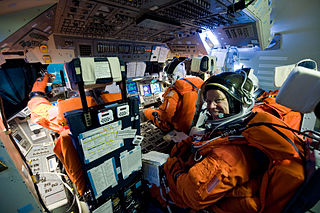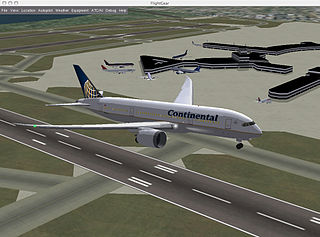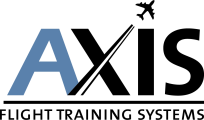
A simulation is an imitative representation of a process or system that could exist in the real world. In this broad sense, simulation can often be used interchangeably with model. Sometimes a clear distinction between the two terms is made, in which simulations require the use of models; the model represents the key characteristics or behaviors of the selected system or process, whereas the simulation represents the evolution of the model over time. Another way to distinguish between the terms is to define simulation as experimentation with the help of a model. This definition includes time-independent simulations. Often, computers are used to execute the simulation.

Aerobatics is the practice of flying maneuvers involving aircraft attitudes that are not used in conventional passenger-carrying flights. The term is a portmanteau of "aeroplane" and "acrobatics". Aerobatics are performed in aeroplanes and gliders for training, recreation, entertainment, and sport. Additionally, some helicopters, such as the MBB Bo 105, are capable of limited aerobatic manoeuvres. An example of a fully aerobatic helicopter, capable of performing loops and rolls, is the Westland Lynx.

A flight simulator is a device that artificially re-creates aircraft flight and the environment in which it flies, for pilot training, design, or other purposes. It includes replicating the equations that govern how aircraft fly, how they react to applications of flight controls, the effects of other aircraft systems, and how the aircraft reacts to external factors such as air density, turbulence, wind shear, cloud, precipitation, etc. Flight simulation is used for a variety of reasons, including flight training, the design and development of the aircraft itself, and research into aircraft characteristics and control handling qualities.

A train simulator is a computer based simulation of rail transport operations. They are generally large complicated software packages modeling a 3D virtual reality world implemented both as commercial trainers, and consumer computer game software with 'play modes' which lets the user interact by stepping inside the virtual world. Because of the near view modeling, often at speed, train simulator software is generally far more complicated software to write and implement than flight simulator programs.

CAE Inc. is a Canadian manufacturer of simulation technologies, modelling technologies and training services to airlines, aircraft manufacturers, healthcare specialists, and defence customers. CAE was founded in 1947, and has manufacturing operations and training facilities in 35 countries.

Driving simulators are used for entertainment as well as in training of driver's education courses taught in educational institutions and private businesses. They are also used for research purposes in the area of human factors and medical research, to monitor driver behavior, performance, and attention and in the car industry to design and evaluate new vehicles or new advanced driver assistance systems.
Combat flight simulators are vehicle simulation games, amateur flight simulation computer programs used to simulate military aircraft and their operations. These are distinct from dedicated flight simulators used for professional pilot and military flight training which consist of realistic physical recreations of the actual aircraft cockpit, often with a full-motion platform.

A motion simulator or motion platform is a mechanism that creates the feelings of being in a real motion environment. In a simulator, the movement is synchronised with a visual display of the outside world (OTW) scene. Motion platforms can provide movement in all of the six degrees of freedom (DOF) that can be experienced by an object that is free to move, such as an aircraft or spacecraft:. These are the three rotational degrees of freedom and three translational or linear degrees of freedom.
Thales Training & Simulation Ltd. is a multinational company which manufactures simulators, including full flight simulators and military simulators, and provides related training and support services. It is a wholly owned subsidiary of the Thales Group.

Shuttle Mission Simulator (SMS) was an umbrella term for three separate simulators for training Space Shuttle crews at the Johnson Space Center (JSC). The simulators were the MBS, the FBS, and the GNS.
Frasca International, Inc., is an American manufacturer of flight simulation training devices, with over 3000 training devices delivered in approximately 70 countries throughout the world. Based in Urbana, Illinois, Frasca International was founded in Champaign, Illinois in 1958 by Rudy Frasca. It is owned by FlightSafety International, a division of Berkshire Hathaway, following an acquisition in 2022.
Frasca flight simulators are used in all segments of the aviation industry, including their extensive use in many prominent college aviation programs, including Purdue University, Indiana State University, Embry-Riddle Aeronautical University, University of North Dakota, Liberty University, Louisiana Tech University, University of Illinois, and Western Michigan University.

Full flight simulator (FFS) is a term used by national (civil) aviation authorities (NAA) for a high technical level of flight simulator. Such authorities include the Federal Aviation Administration (FAA) in the United States and the European Aviation Safety Agency (EASA).

The Neutral Buoyancy Simulator was a neutral buoyancy pool located at NASA's George C. Marshall Space Flight Center (MSFC). Engineers and astronauts developed hardware and practiced procedures in this tank from its completion in 1968 through its decommissioning in 1997. Marshall recognized the need for underwater simulations of extra-vehicular activities (EVAs) and developed three successively larger tanks for the purpose. The Neutral Buoyancy Simulator contributed significantly to the American crewed space program. Skylab, the Space Shuttle, Hubble Space Telescope, and the International Space Station have all benefited from the Neutral Buoyancy Simulator. Until Johnson Space Center constructed the Weightless Environment Test Facility in the mid-1970s, MSFC had the only NASA-owned test facility that allowed engineers and astronauts to become familiar with the dynamics of body motion under weightless conditions.

Indoor golf is an umbrella term for all activities in golf which can be carried out indoors. Venues include indoor driving ranges, chipping areas, putting greens, machines and home golf simulators. Many of these indoor facilities are businesses that include additional entertainment options as well as food and drink for customers.

A flight simulation video game refers to the simulation of various aspects of flight or the flight environment for purposes other than flight training or aircraft development. A significant community of simulation enthusiasts is supported by several commercial software packages, as well as commercial and homebuilt hardware. Open-source software that is used by the aerospace industry like FlightGear, whose flight dynamics engine (JSBSim) is used in a 2015 NASA benchmark to judge new simulation code to space industry standards, is also available for private use. A popular type of flight simulators video games are combat flight simulators, which simulate combat air operations from the pilot and crew's point of view. Combat flight simulation titles are more numerous than civilian flight simulators due to variety of subject matter available and market demand.

GSE Systems, Inc. develops and markets software-based simulation and training products to nuclear, oil, and gas electricity generators, and the chemical process industries. It also sells software for monitoring and optimizing plant and signal analysis to the power industry.

Simulator rides are a type of amusement park or fairground ride, where the audience is shown a movie while their seats move to correspond to the action on screen.
ATP Flight School is the largest flight training company in the United States. The curriculum focuses on airline-oriented pilot programs at locations across the country. ATP is the leading supplier of professionally trained pilots to the nation's regional airlines.
Simulator sickness is a subset of motion sickness that is typically experienced while playing video games from first-person perspective. It was discovered in the context of aircraft pilots who undergo training for extended periods of time in flight simulators. Due to the spatial limitations imposed on these simulators, perceived discrepancies between the motion of the simulator and that of the vehicle can occur and lead to simulator sickness. It is similar to motion sickness in many ways, but occurs in simulated environments and can be induced without actual motion. Symptoms of simulator sickness include discomfort, apathy, drowsiness, disorientation, fatigue, and nausea. These symptoms can reduce the effectiveness of simulators in flight training and result in systematic consequences such as decreased simulator use, compromised training, ground safety, and flight safety. Pilots are less likely to want to repeat the experience in a simulator if they have suffered from simulator sickness and hence can reduce the number of potential users. It can also compromise training in two safety-critical ways:
- It can distract the pilot during training sessions.
- It can cause the pilot to adopt certain counterproductive behaviors to prevent symptoms from occurring.
Unmanned aircraft system simulation focuses on training pilots to control an unmanned aircraft or its payload from a control station. Flight simulation involves a device that artificially re-creates aircraft flight and the environment in which it flies for pilot training, design, or other purposes. It includes replicating the equations that govern how aircraft fly, how they react to applications of flight controls, the effects of other aircraft systems, and how the aircraft reacts to external factors such as air density, turbulence, wind shear, cloud, precipitation, etc.
















